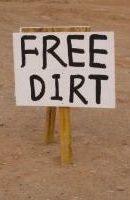 Importing Topsoil - April 9, 2014 Jeff Schalau, Agent, Agriculture & Natural Resources University of Arizona Cooperative Extension, Yavapai County Many gardeners find the need to import soil to their property. They may be putting in some raised beds, backfilling a retaining wall, or simply need something to cover the rocks and caliche that pass for native soil in our area. Before bringing in new soil to solve existing problems, consider some of the pitfalls (lame pun intended) your new topsoil may create. To a soil scientist or a farmer, topsoil is the darker layer of soil that is found at the very surface of the soil profile. Topsoil is dark and more fertile than the deeper underlying soil because of organic matter decomposition over time: plant litter falls and decomposes, roots die, and other micro and macro organisms make their living and do their business above and below ground. These organic matter additions increase water infiltration rate, water holding capacity, add necessary plant nutrients, and create a bank account of nutrients which are released slowly over time. Now consider the range of topsoil products that you may encounter when shopping around. Nurseries sell bagged topsoil products that I would categorize as organic amendments. Bagged topsoil is usually a very good plant-growing medium, but can get quite expensive when used for large jobs. Some nurseries also mix and market their own topsoil by the truckload. These products may include mineral soil, compost (or partially decomposed coarse woody debris), and possibly some fertilizer. In this case, the nursery should be able to tell you what the materials are and where they came from. Inexpensive topsoil may actually be better described as "fill". These materials may have been excavated from deep within the soil profile. In some cases, these materials are subsoil rather than topsoil. If so, they contain some small soil-sized particles mixed and partially decomposed rock with little or no organic matter. When considering this type of material for a plant growth media, compare it to your existing soil before purchasing. Worse yet, the material may be labeled as "free fill". Before bring it to your yard consider what it could contain and inspect it for construction debris, caliche, or other unwanted materials. Another consideration is whether the material contains weed seeds or rhizomes. By looking around at where the soil came from and learning about the weeds found in those areas, you can get a pretty good idea as to whether it contains weeds or not. If the seller or giver cannot provide you with the source location, then don't take it for landscape purposes. Following are some weedy species you should be aware of in the Verde Valley area. The following examples are a few of the worst offenders and prior vigilance could prevent a serious weed control effort later on. See below for photos and additional information about these weeds. Johnsongrass (Sorghum halepense) Soils could contain seed and underground rhizomes. It often grows on roadsides and ditch banks and can be between 2 to 8 feet tall. The rhizomes can be almost as big around as your finger. Bermudagrass (Cynodon dactylon) Soils could contain seed, aboveground stolons, and underground rhizomes. Stolons and rhizomes are small1/16 to 1/8 inch in diameter, jointed like bamboo, and may or may not have roots and/or new shoots emerging from the joints. Yellow Starthistle (Centaurea solstitialis) Soils could contain seed. This plant can be found on roadsides on the south end of Camp Verde (Hwy 260, Salt Mine Rd., Quarterhorse Ln, Verde Lakes area). Fill from this area could contain yellow starthistle seed. Field Bindweed (Convolvulus arvensis) spreads by seeds and rhizomes. The plant is a vining perennial that can overrun vegetable plantings. This weed is a common occurrence on previously cultivated areas. If you have read this far and are still not afraid, then here are some suggestions to make your topsoil importation successful. Don't skimp - if you are going to add soil, put down at least 4 inches and incorporate it into the existing soil. Simply putting good soil on top of bad will create a distinct boundary which will hamper water infiltration and root penetration – the two soils must be mixed. If necessary, screen the material through ½” hardware cloth and remove rocks. Observe for weeds and treat as necessary. Establish new plants or a garden quickly to get the area occupied by desirable plants that compete with weeds. Continue to manage weeds as needed. Follow the Backyard Gardener on Twitter – use the link on the BYG website. If you have other gardening questions, call the Master Gardener help line in the Camp Verde office at 928-554-8999 Ext. 3 or e-mail us at verdevalleymg@gmail.com and be sure to include your name, address and phone number. Find past Backyard Gardener columns or provide feedback at the Backyard Gardener web site: http://cals.arizona.edu/yavapai/anr/hort/byg/. Additional Resources Johnsongrass Identification University of California IPM Online http://ucipm.ucdavis.edu/PMG/WEEDS/johnsongrass.html Bermudagrass Identification University of California IPM Online http://ucipm.ucdavis.edu/PMG/WEEDS/bermudagrass.html Yellow Starthistle Identification University of California IPM Online http://www.ipm.ucdavis.edu/PMG/WEEDS/yellow_starthistle.html Field Bindweed Identification University of California IPM Online http://www.ipm.ucdavis.edu/PMG/WEEDS/field_bindweed.html |